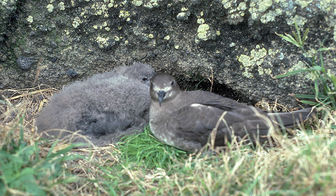Kermadec Petrel
It is found in Australia, Chile, Japan, Mexico, Micronesia, New Zealand, Norfolk Island, Pitcairn, and the United States.

Original source: Lance AndrewesPermission(Reusing this file)This image, which was originally posted to Flickr.com, was uploaded to Commons using Flickr upload bot on 08:40, 6 July 2008 (UTC) by Kahuroa (talk). On that date it was licensed under the license below. This file is licensed under the Creative Commons Attribution-Share Alike 2.0 Generic license.You are free:to share – to copy, distribute and transmit the work
Author: Lance AndrewesPermission(Reusing this file)This image, which was originally posted to Flickr.com, was uploaded to Commons using Flickr upload bot on 08:40, 6 July 2008 (UTC) by Kahuroa (talk). On that date it was licensed under the license below. This file is licensed under the Creative Commons Attribution-Share Alike 2.0 Generic license.You are free:to share – to copy, distribute and transmit the work
The Kermadec Petrel is classified as Least Concern. Does not qualify for a more at risk category. Widespread and abundant taxa are included in this category.
The Kermadec Petrel (Pterodroma neglecta) is a species of seabird in the Procellariidae family. It is found in Australia, Chile, Japan, Mexico, Micronesia, New Zealand, Norfolk Island, Pitcairn, and the United States. Its natural habitat is open seas. References - * BirdLife International 2004. Pterodroma neglecta. 2006 IUCN Red List of Threatened Species. Downloaded on 24 July 2007. More
probable that Kermadec Petrel is a regular visitor to waters around the central and Northern Pacific. Occurs as a regular visitor off eastern Australia (New South Wales), and New Zealand (Kaikoura). Presumably these include birds that breed on Lord Howe Island (Australia) and Henderson Island (New Zealand). Has been recorded in Japan. More
A record of Kermadec Petrel (Pteredroma neglecta) on Kaua'i, Hawai'i during the summers of 1998, 1999 and 2000. - - On the evening of 11th July 1998 I was birdwatching at Kilauea Point National Wildlife Refuge, awaiting the regular evening flyover of Hawaiian Petrels (Pterodroma sandwichensis). More
Kermadec Petrel, in flight. Kermadec Petrel, in flight. More
The similar Kermadec Petrel and Herald petrels are common nesters of the motus (islets) located in the eastern coast of the main island. The completely dark Henderson Petrel (Pterodroma atrata) has been previously reported by Jaramillo et al. to the island. Kermadec Petrel has distinctive primary white shafts in the upperwing at all the phases, even in very dark individuals. This feature is normally quite distinctive in the field. It is a stocky petrel with broad wings and broad wedge-shaped tail. More
Above: Kermadec petrel pair at nest site Above: Kermadec storm-petrel This site is maintained and copyrighted by Wrybill Birding Tours, NZ 2003. All photos (unless otherwise stated) were taken by Brent Stephenson @ Eco-Vista and are copyrighted 2003. The use of any image without permission is not allowed. However, all photos on this site are for sale, please email Brent for more information or check out Eco-Vista's website for details. More
The Kermadec Petrel, Pterodroma neglecta, known in the Marshall Islands as Mum, resides year-round in the Pacific. This attractive bird boasts varied plumage, depending on the phase, that can make it difficult to identify. The Kermadec Petrel can have dark brown upperparts, throat, breast and undertail contrasting with a white belly. The petrel may also be white-throated with a broad, dark breast band, or completely dark except for mottled white below. More
* Pterodroma neglecta, Kermadec Petrel, breeds on islands of the south Pacific from New Zealand to Easter Island, Juan Fernández Islands, San Ambrosio, and San Félix * Pterodroma neglecta neglecta breeds on south Pacific islands from New Zealand to Easter Island * Pterodroma neglecta juana breeds on Juan Fernández Islands, San More
For the purposes of our bird news services, Kermadec Petrel is classed as Mega: species which have not yet occurred in the British Isles or are exceedingly rare, or are otherwise highly desirable. show section Products featuring Kermadec Petrel (1) BWPi DVD-ROM 2.0 (DRBWP: £135.95) show section External Links (0) We currently have no external links for this species. More
parasitism by Kermadec Petrels on other large procellariids, and further hypothesize that this petrel is successful as a parasite because it is a foraging mimic of the subadults of the larger skuas (Pomarine Jaegers and South Polar Skuas ) through its similarity of color pattern, flight profile, and behavior when initiating an attack, and because the large skuas (its models) are very effective as parasites. More
cats and rats on Raoul Island, Kermadec petrels were perhaps only to be found on the offshore islets at the time of this image (1975/1976).This chick on Meyer Island is loosing its down. To take full advantage of Flickr, you should use a JavaScript-enabled browser and install the latest version of the Macromedia Flash Player. Comments view profile Keith@Worldbirds. More
The storm-petrels and the small number of Kermadec Petrels were scattered throughout the cruise track. As might be expected, Galapagos Petrel, Madeiran Storm-Petrel and Galapagos Storm-Petrel were most numerous in the vicinity of their nesting islands, although surprisingly they were sometimes encountered well away from the Galapagos Islands as well. Bear in mind that this is probably an over simplification of a complex situation. More
Family : Procellariidae
Genus : Pterodroma
Species : neglecta
Authority : (Schlegel, 1863)
